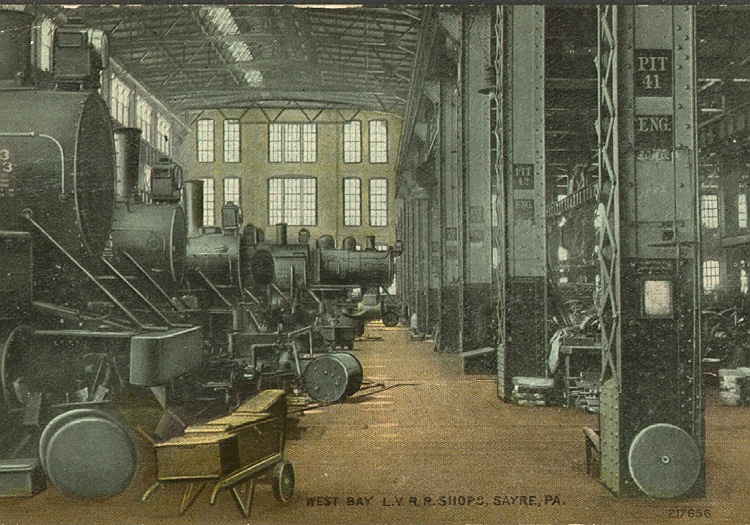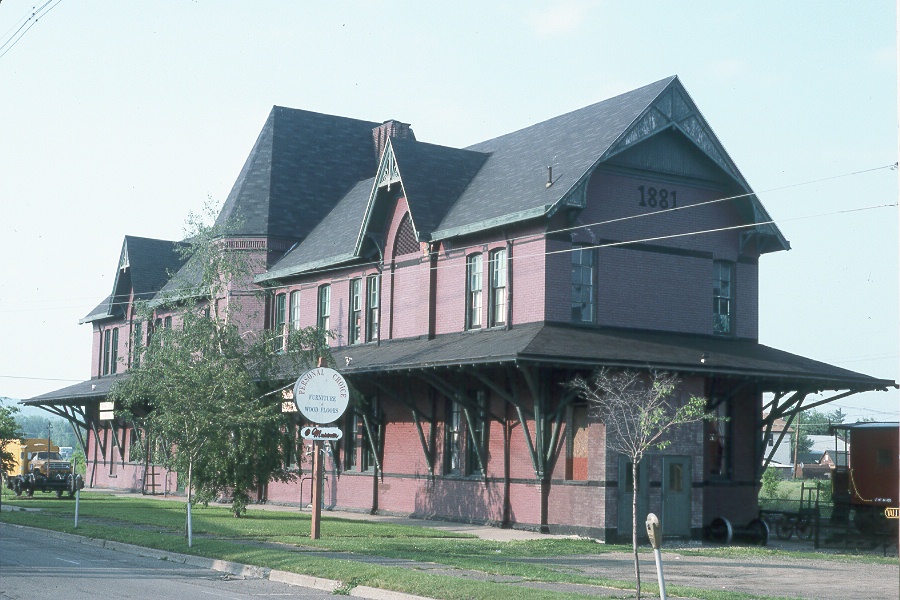Sayre,
Pennsylvania
Once
a strong, busy and vital railroad town, Sayre, Pennsylvania is today a quiet
place, one where time seems to have passed it by. Home to the Northern
division headquarters for the former Lehigh Valley Railroad, Sayre provided
thousands of jobs to railroad employees from the 1870’s through the
railroad’s golden age and on into the post World War II era.
Sayre was a town that was never quiet. Around the clock railroad
activity hummed along the Valley’s mainline. The nearby massive locomotive
erection shops added their own background music to a symphony song of the
railroad age. The sounds of steam locomotion and the rumble of freight and
coal trains were ever present.
The
present Sayre depot dates from 1881. It replaced a temporary structure which
substituted for the original depot that burned in 1875. This was just a few
years after the town had been renamed from South Central Junction. The
railroad’s original chief engineer, Robert Sayre had the newly bustling
junction named after him by the Lehigh’s Asa
Packer, one of the 19th Century’s most prolific rail
entrepreneurs. The present structure is built in a High Victorian Gothic
style, and has details in the Queen Anne motif. The railroad also constructed
a three story brick office building. (This was demolished about 1950). Both
structures were meticulously landscaped with trees and flowers and were the
pride of the railroad during the Valley’s golden age.
Sayre
was also home to a well-known medical facility which began in the former home
of Robert Packer, son of the railroad’s master builder. Robert Packer
embraced new technology when he installed the first direct telephone line in
the Sayre area, connecting his home with the railroad’s offices in the Sayre
yard.
Dating
to 1878, the shops at Sayre replaced outmoded ones originally located in
Waverly. Sayre joined Packerton and Easton as a principal heavy repair center.
In 1904, a new shop complex opened in Sayre. Massive traveling cranes had been
adopted by American railroads just a few years before, and the Valley’s
Sayre shops became one of the first ones to be so equipped. These wonders of
the machine age could lift an entire locomotive and easily move it to the next
repair point within the shop. By the turn of the 20th century,
locomotive motive power was undergoing much standardization and the Lehigh
Valley followed suit. When opened, the new shops could turn out one new or
rebuilt steam locomotive a day. Sayre became the focal point as the railroad
modernized and expanded its physical plant to meet the demands of a booming
industrial economy. The melodious song of the steam age grew into a chorus at
Sayre.

West Bay, LVRR Shops, Sayre, Pa.
From a historic postcard, Published by The Subway, Sayre, Pa.
The date is obscured on the postmark.
We can guess it is circa 1910.
The
Lehigh Valley was for many years primarily a coal hauler, one of the several
“Anthracite Roads” transporting the flood of “Black Diamonds” from the
Wilkes-Barre and Scranton areas of Pennsylvania. Coal, the lifeblood of the
early industrial age was the foundation for the railroad’s success. However,
as early as the turn of the 20th century, general merchandise
carloadings exceeded coal traffic. The Buffalo, NY extension had been completed
in 1892, and the Valley slowly assumed the role of a fast freight expediter
between the Buffalo gateway and New York City tidewater. Although it was freight
and coal that paid the bills, the LVRR hosted several passenger trains
proclaimed as the “Handsomest Trains in the World”. The famous Black Diamond
was the railroad’s premier Buffalo to New York daylight accommodation.
Throughout
the early part of the 20th Century, the railroad continued improving
it’s steam motive power, culminating in the very handsome 4-8-4 Wyoming
series. The success of this locomotive with freight led to the railroad’s
1934-35 order for five passenger engines of the same wheel arrangement. Oddly,
the railroad did not seem to use these in regular passenger service, preferring
to assign them to heavy milk trains. During World War II, the railroad took
delivery of ten 4-8-4’s from Alco. Designated class T-2b, these would be the
newest steam locomotives to be scrapped. They were in nearly new condition when
sent to the scrapper in 1951. The age of the diesel had arrived, and the
pressures of the post war economy found the Valley in a struggle for survival.
But
let us return to Sayre and imagine a summer afternoon in 1929. On the station
platform are baggage wagons loaded with express and milk cans waiting for the
afternoon milk train. Milling around are the usual assortment of small town
kids, a few adults, and some old timers now retired from the railroad anxiously
anticipating the arrival of the westbound Black Diamond. On an adjacent track,
one of the Valley’s dual-purpose Pacific locomotives is being readied for her
next assignment. Hefty steam switchers are shuffling around the yards. The
sounds from the backshops add additional atmosphere to the scene. Soon the Black
Diamond is at the station. With crisp precision, the passenger loading business
is quickly concluded and the train whistles off. Soon the last car rolls past.
Today it is the solarium parlor-lounge “Black Diamond”, one of a pair built
in 1927 that the railroad owns. The sounds of the westbound Diamond slowly fade
away on the Lehigh Valley Railroad.

The
Lehigh Valley Railroad depot at Sayre, Pennsylvania
Photo:
June 7, 1994 by John C. Dahl
|